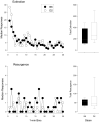Delay discounting in C57BL/6J and DBA/2J mice: adolescent-limited and life-persistent patterns of impulsivity
- PMID: 21463022
- PMCID: PMC3198828
- DOI: 10.1037/a0022919
Delay discounting in C57BL/6J and DBA/2J mice: adolescent-limited and life-persistent patterns of impulsivity
Abstract
Impulsivity is a defining characteristic of adolescence. Compared to adults, for example, adolescents engage in higher rates of drug and alcohol experimentation, risky sexual practices, and criminal activity. Such behavior may reflect reduced sensitivity to long-term consequences of behavior during adolescence. Recently, our lab has attempted to refine mouse procedures to study developmental trends in decision making in the laboratory. In the present experiment, we examined sensitivity to delayed rewards in C57BL/6J (B6) and DBA/2J (D2) mice during adolescence and adulthood using an adaptation of a 2-week delay discounting procedure developed by Adriani and Laviola (2003). During training, mice could choose between a 20- or 100-μl drop of milk delivered after a 1-s delay. During testing, the delay to the large drop of milk was increased from 1 to 100 seconds. As the delay to the larger volume increased, preference shifted to the smaller, more immediate option. In adolescence, both strains showed similar shifts in preference. In contrast, adult B6 mice were less sensitive to increasing delays than were adult D2 mice, who continued to perform much as their adolescent counterparts. A subsequent resistance-to-extinction test ruled out the possibility that the slower change in the adult B6 mice was due to perseverative responding. The present findings suggest that B6 and D2 strains may be differentially suited to uncovering the biological mechanism of short-term and long-term patterns of impulsive behavior.
(PsycINFO Database Record (c) 2011 APA, all rights reserved).
Figures


Similar articles
-
Impact of strain and D-amphetamine on impulsivity (delay discounting) in inbred mice.Psychopharmacology (Berl). 2006 Oct;188(2):144-51. doi: 10.1007/s00213-006-0478-0. Epub 2006 Aug 17. Psychopharmacology (Berl). 2006. PMID: 16915383
-
Repeated ethanol exposure during early and late adolescence: double dissociation of effects on waiting and choice impulsivity.Alcohol Clin Exp Res. 2014 Oct;38(10):2579-89. doi: 10.1111/acer.12535. Alcohol Clin Exp Res. 2014. PMID: 25346503
-
Alleviating waiting impulsivity and perseverative responding by μ-opioid receptor antagonism in two inbred mouse strains.Psychopharmacology (Berl). 2015 Apr;232(8):1483-92. doi: 10.1007/s00213-014-3786-9. Epub 2014 Nov 8. Psychopharmacology (Berl). 2015. PMID: 25381183
-
Exaggerated waiting impulsivity associated with human binge drinking, and high alcohol consumption in mice.Neuropsychopharmacology. 2014 Dec;39(13):2919-27. doi: 10.1038/npp.2014.151. Epub 2014 Jun 20. Neuropsychopharmacology. 2014. PMID: 24947901 Free PMC article.
-
Cognitive impulsivity in animal models: role of response time and reinforcing rate in delay intolerance with two-choice operant tasks.Neuropharmacology. 2010 Mar-Apr;58(4-5):694-701. doi: 10.1016/j.neuropharm.2009.11.007. Epub 2009 Nov 27. Neuropharmacology. 2010. PMID: 19945469 Review.
Cited by
-
Determinants of choice, and vulnerability and recovery in addiction.Behav Processes. 2016 Jun;127:35-42. doi: 10.1016/j.beproc.2016.04.001. Epub 2016 Apr 12. Behav Processes. 2016. PMID: 27083500 Free PMC article. Review.
-
Dopamine D2 receptors in nucleus accumbens cholinergic interneurons increase impulsive choice.bioRxiv [Preprint]. 2023 Jan 20:2023.01.20.524596. doi: 10.1101/2023.01.20.524596. bioRxiv. 2023. Update in: Neuropsychopharmacology. 2023 Aug;48(9):1309-1317. doi: 10.1038/s41386-023-01608-1. PMID: 36711450 Free PMC article. Updated. Preprint.
-
Effects of adolescent exposure to methylmercury and d-amphetamine on reversal learning and an extradimensional shift in male mice.Exp Clin Psychopharmacol. 2017 Apr;25(2):64-73. doi: 10.1037/pha0000107. Epub 2017 Mar 13. Exp Clin Psychopharmacol. 2017. PMID: 28287789 Free PMC article.
-
Role of prefrontal 5-HT in the strain-dependent variation in sign-tracking behavior of C57BL/6 and DBA/2 mice.Psychopharmacology (Berl). 2016 Apr;233(7):1157-69. doi: 10.1007/s00213-015-4192-7. Epub 2016 Jan 4. Psychopharmacology (Berl). 2016. PMID: 26728892
-
Mouse strain differences in punished ethanol self-administration.Alcohol. 2017 Feb;58:83-92. doi: 10.1016/j.alcohol.2016.05.008. Epub 2016 Oct 18. Alcohol. 2017. PMID: 27814928 Free PMC article.
References
-
- Adriani W, Laviola G. Elevated levels of impulsivity and reduced place conditioning with d-amphetamine: two behavioral features of adolescence in mice. Behavioral Neuroscience. 2003;117:695–703. - PubMed
-
- Adriani W, Rea M, Baviera M, Invernizzi W, Carli M, Ghirardi O, Caprioli A, Laviola G. Acetyl-L-carnitine reduces impulsive behavior in adolescent rats. Psychopharmacology. 2004;176:296–304. - PubMed
-
- Arnett J. Reckless behavior in adolescence: a developmental perspective. Developmental Review. 1992;12:339–373.
-
- Belknap JK, Crabbe JC, Young ER. Voluntary consumption of ethanol in 15 inbred strains. Psychopharmacology. 1993;112:503–510. - PubMed
Publication types
MeSH terms
Grants and funding
LinkOut - more resources
Full Text Sources
Research Materials
Miscellaneous

